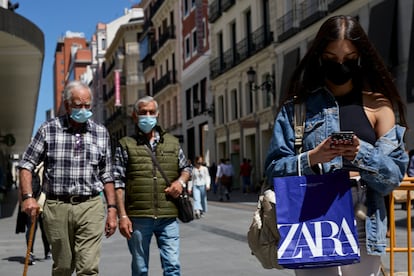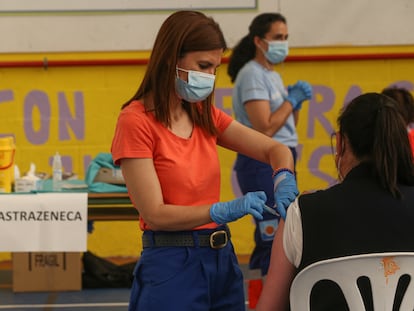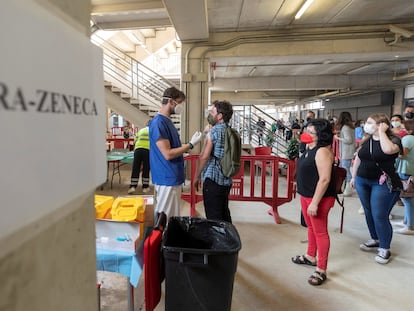Is it time for Spain to end the mandatory use of face masks outdoors?
Experts are divided on whether the measure should be lifted, with some arguing that coronavirus transmission rates need to be lower and vaccination coverage higher for it to be considered


Face masks have become the major social barrier against coronavirus transmission, and while there is still not a definitive date for their obligatory use in Spain to be revised, the Health Ministry is due to study an eventual relaxation of the necessity to wear the coverings while outside.
The central government has not specified a timescale for this decision, but as the vaccination campaign advances – 36% of the population now has at least one dose of a Covid-19 vaccine – and the transmission of the virus falls, a scenario of uncovered faces while in the open air is getting closer.
For the moment, the European Centre for Disease Prevention and Control (ECDC) has already recommended reducing their use among people who are vaccinated, and countries such as Israel and the United States, which have higher vaccination rates, have stopped requiring their use in the streets.
The logical thing will be that by August we are not obliged to wear masks when there is social distanceRafael Ortí Lucas, president of the Spanish Society of Preventive Medicine, Public Health and Hygiene
But experts in Spain remain divided on the issue, and while some back relaxing face mask rules, others are calling for caution – at least until the vaccination campaign progresses further and the incidence falls even lower. Currently, the 14-day cumulative number of coronavirus cases per 100,000 inhabitants is at 126, which is still medium risk according to the Health Ministry’s traffic-light system. Some regions, such as the Basque Country and Madrid, are still at high risk.
At the outset of the pandemic in Spain, back in March 2020, a lack of supply of masks and other personal protective equipment prompted the government to stop short of recommending their use among the general population. During the deescalation of the first lockdown, however, they gradually became obligatory across the whole country, even when outside in the open air.
The scientific evidence pointed to their benefits while inside, in particular, to prevent transmission via droplets and aerosols, but their use outside has always been questioned. A blanket requirement to use face masks, however, whether indoors or outdoors, has avoided confusion among the Spanish population. The rest of the non-pharmacological measures have been modified according to the epidemiological evolution of the pandemic, but masks have been here to stay ever since last summer.
As the situation in Spain improves, however, there are more and more voices in favor of relaxing the measure – not least given that they are obligatory in all spaces outside, but there are exceptions in Spain in certain indoor situations, where the risk is greater.

A statement from the Madrid Public Health Association had this to say about the requirements: “This measure is absurd, because it obliges the use of masks in environments of low or zero risk, such as in the countryside or the streets of our towns and villages, while there are still exceptions for use in environments where there is proven risk, such as interiors of work centers, where people who do not live together share the same space for hours at a time.”
In the same vein, bars and restaurants have also been a part of this argument, given that they are places where the risk of transmission is higher but also where people can remove the face coverings so that they can eat and drink.
“The logical thing will be that by August we are not obliged to wear masks when there is [social] distance,” argued Rafael Ortí Lucas, the president of the Spanish Society of Preventive Medicine, Public Health and Hygiene. “We have a falling trend of the cumulative incidence and a vaccination curve that is growing in terms of quality and quantity: seniors already have coverage. It’s still a bit early because we have parts of the risk groups without vaccines, but it’s a question of common sense.” More than 94% of the over-60s, which is the most vulnerable age group, have received at least one dose of the vaccine in Spain, while the cumulative incidence has now fallen to levels last seen in August 2020.
The ECDC has already recommended relaxing the use of masks among people who have been vaccinated and even when individuals who live together and have not had their shots mix with people who have, provided there are no other risk elements. The Center for Disease Control (CDC) in the US, meanwhile, has gone even further and after announcing in March of this year that people who have been vaccinated can meet without wearing masks, on May 13 it gave permission for everyone who has been vaccinated to stop using them, whether they are inside or outside.
We shouldn’t even be considering relaxing face mask rules while the incidence is still very high in a lot of SpainDaniel López-Acuña, former director of emergencies at the World Health Organization
Spain is looking at this scenario, but with hesitancy. “There are no deadlines yet,” a Health Ministry spokesperson said regarding the use of masks. “We still need to be prudent and maintain all of the prevention and safety measures.”
Fernando Simón, the director of the Health Ministry’s Coordination Center for Health Alerts (CCAES), said last week that it is “very possible” that the use of masks outside would be relaxed “not too many days from now.” On Monday, however, he pointed out that there is currently a law that obliges their use in outdoor and indoor public spaces, and that making changes to such legislation “is not so easy.”
In fact, this legislation caused widespread rejection among regional governments when it became law in March, having been drafted during the deescalation process months earlier. The Health Ministry had to intervene and propose a revision of the rules so that masks would not be mandatory while on the beach, but they would be if you were taking a stroll along the shoreline, for example.
While the Spanish health authorities decide the future of mask-wearing in the country, the central government has already proposed that the face coverings be obligatory during the next academic year for all children aged six and upward. That measure, however, has already been questioned by the authorities in the Catalonia region, which is leaving the door open to not requiring masks for children up to the end of primary education (aged 11 or 12) if the epidemiological situation allows, and assuming classes remain in their bubbles. “I see the Catalan position as more reasonable,” said Toni Trilla, the head of preventive medicine at Barcelona’s Clínic Hospital. “It’s possible that the government is being overly prudent. I think the concept of a stable bubble is much more manageable.”
The vaccination drive is helping move the country toward a time when masks are no longer required, protecting those who have had their shots from serious illness and also reducing the risk of transmission to others. But the speed of the process, some experts argue, is still not fast enough for the use of masks to be relaxed.
While the risk of transmission is lower among people who have been vaccinated against Covid-19, it’s still possible to get infected and to infect others
“This is not a reasonable debate right now,” argued Daniel López-Acuña, a former director of emergencies at the World Health Organization (WHO). “It’s more than premature and could even be irresponsible. We shouldn’t even be considering it while the incidence is still very high in a lot of Spain and the number of people who have got the full protection from the vaccines is still very small.” The health expert points out that while the risk of transmission is lower among people who have been vaccinated, it’s still possible to get infected and to infect others.
Alberto Infante, an emeritus professor at the National Health School, agrees. “Out of a principal of caution and prudence, I would be in favor of masks being the last non-pharmacological measure to be lifted. It’s true that as the vaccination progresses, the justification for not wearing masks in open spaces without crowds is greatly reduced. But we should have low transmission rates and substantial levels of vaccination,” he argued.
The experts are also divided on when the right moment would be to relax the restriction. While Simón suggested that a medium-risk scenario (fewer than 150 cases per 100,000 inhabitants) would be sufficient, López-Acuña goes further. “From my point of view, we can only start to consider no longer using masks when the cumulative incidence is below 25 per 100,000, and 70% of the population has been vaccinated with two doses,” he argued. “At the earliest, by September. And I think that we will have to continue to use them in hospitals, public transportation and senior residences.”
Trilla, meanwhile, believes that “their use outside could be relaxed in June or July.” He agrees with López-Acuña that they will have to remain in use in certain environments. “It would be good to continue with them in hospitals, for emergency room patients, on public transport… But not just due to the coronavirus, but also for other respiratory viruses,” he said.
The most cautious experts, however, fear that the public will get the wrong message if the required uses of masks are relaxed. “If we do it now, we send out a message that this is all over, and that’s not the case,” Infante explained.
English version by Simon Hunter.
Tu suscripción se está usando en otro dispositivo
¿Quieres añadir otro usuario a tu suscripción?
Si continúas leyendo en este dispositivo, no se podrá leer en el otro.
FlechaTu suscripción se está usando en otro dispositivo y solo puedes acceder a EL PAÍS desde un dispositivo a la vez.
Si quieres compartir tu cuenta, cambia tu suscripción a la modalidad Premium, así podrás añadir otro usuario. Cada uno accederá con su propia cuenta de email, lo que os permitirá personalizar vuestra experiencia en EL PAÍS.
¿Tienes una suscripción de empresa? Accede aquí para contratar más cuentas.
En el caso de no saber quién está usando tu cuenta, te recomendamos cambiar tu contraseña aquí.
Si decides continuar compartiendo tu cuenta, este mensaje se mostrará en tu dispositivo y en el de la otra persona que está usando tu cuenta de forma indefinida, afectando a tu experiencia de lectura. Puedes consultar aquí los términos y condiciones de la suscripción digital.
More information
Últimas noticias
Most viewed
- Sinaloa Cartel war is taking its toll on Los Chapitos
- Oona Chaplin: ‘I told James Cameron that I was living in a treehouse and starting a permaculture project with a friend’
- Reinhard Genzel, Nobel laureate in physics: ‘One-minute videos will never give you the truth’
- Why the price of coffee has skyrocketed: from Brazilian plantations to specialty coffee houses
- Silver prices are going crazy: This is what’s fueling the rally










































